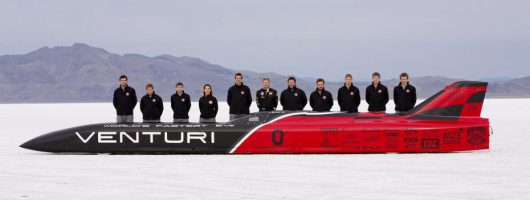
Buckeye Bullet is a student engineering team that develops electric vehicle technology. The team created a vehicle that broke the land speed record driving 314.4 mph. Credit: Courtesy of the Ohio State Center for Automative Research
While the maximum speed limit in Ohio is 70 mph, a few Buckeyes helped their vehicle go about 270 mph faster earlier this month.
Ohio State’s Venturi Buckeye Bullet 3 team — consisting of undergraduate and graduate students, and their driver, Roger Schroer — achieved a new world record of 341.4 miles per hour on Sept. 19, smashing its previous world record of 307.7 mph, which was set in 2010.
The new record was set in at the Bonneville Salt Flats in Utah, with the electric-powered vehicle, the Venturi Buckeye Bullet 3. Federation Internationale de l’Automobile, the worldwide governing body of motor sport, is processing the official certification of the record.
Michael Johanni, team leader and recent graduate in aviation engineering, said the next goal is to reach 400 mph. By reaching this speed, he wants to demonstrate that electric vehicles can compete with gasoline-powered vehicles.
“We want everybody to just say, ‘Wow, that was really fast,’” Johanni said. “To get to that level and prove that electric vehicles could compete with their gas (equivalents), we realize that the car has to pass 400 mph.”
Johanni and his teammates spent six years building and designing VBB-3. When building it, the team’s greatest challenge was getting as much power as possible out of the vehicle.
To generate more power, massive lithium-ion batteries were used to provide a 3,000 horsepower output, and each axle was equipped with a motor to provide all-wheel drive.
“Because of the expertise and strength of the people on this team, we are able to achieve the first step of our project and goals,” Johanni said.
David Cooke, staff team liaison and researcher at OSU’s Center for Automotive Research, said a significant amount of research was put into to the batteries and motors in order to break through technological limits of electric-powered vehicles.
“The goal is not just to run fast, but to show the world these new technologies can push the electric vehicle technologies to their limit,” Cooke said.
Leading up to the race, Johanni said he and his team spent an average of 40 hours each week on the racing program, and even more during the summer.
“It’s a really cool opportunity. We get to do a lot of things in this program that most college students never get the chance to do,” Johanni said.


